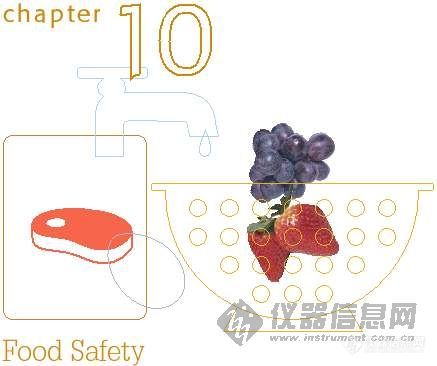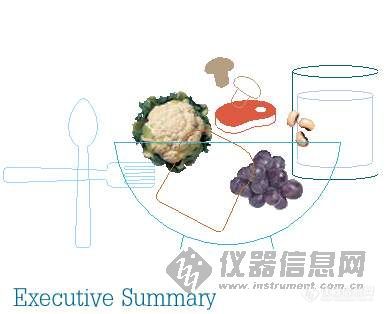-
+关注
私聊
-

云中漫步
第12楼2006/11/02
MESSAGE FROM THE SECRETARIES
We are pleased to present the 2005 Dietary Guidelines for Americans. This document is intended to be a primary
source of dietary health information for policymakers, nutrition educators, and health providers. Based on the latest
Dietary Guidelinesprovides information and advice for choosing a nutritious diet,
scientific evidence, the 2005
maintaining a healthy weight, achieving adequate exercise, and “keeping foods safe” to avoid foodborne illness.
This document is based on the recommendations put forward by the Dietary Guidelines Advisory Committee. The
Committee was composed of scientific experts who were responsible for reviewing and analyzing the most current
dietary and nutritional information and incorporating this into a scientific evidence-based report. We want to thank
them and the other public and private professionals who assisted in developing this document for their hard work
and dedication.
The more we learn about nutrition and exercise, the more we recognize their importance in everyday life. Children
need a healthy diet for normal growth and development, and Americans of all ages may reduce their risk of chronic
disease by adopting a nutritious diet and engaging in regular physical activity.
However, putting this knowledge into practice is difficult. More than 90 million Americans are affected by chronic
diseases and conditions that compromise their quality of life and well-being. Overweight and obesity, which are
risk factors for diabetes and other chronic diseases, are more common than ever before. To correct this problem,
many Americans must make significant changes in their eating habits and lifestyles.
We live in a time of widespread availability of food options and choices. More so than ever, consumers need good
Dietary Guidelineswill help Americans choose a
advice to make informed decisions about their diets. The 2005
Dietary
nutritious diet within their energy requirements. We believe that following the recommendations in the
will assist many Americans in living longer, healthier, and more active lives.
Guidelines
Tommy G. Thompson Ann M. Veneman
Secretary of Health and Human Services Secretary of Agriculture
-
+关注
私聊
-

云中漫步
第13楼2006/11/02
ACKNOWLEDGMENTS
The U.S. Department of Health and Human Services (HHS) and the U.S. Department of Agriculture (USDA) acknowledge
the recommendations of the Dietary Guidelines Advisory Committee—the basis for this edition. The Committee
consisted of Janet C. King, Ph.D., R.D. (chair), Lawrence J. Appel, M.D., M.P.H., Benjamin Caballero, M.D., Ph.D., Fergus
M. Clydesdale, Ph.D., Penny M. Kris-Etherton, Ph.D., R.D., Theresa A. Nicklas, Dr.P.H., M.P.H., L.N., F. Xavier Pi-Sunyer,
M.D., M.P.H., Yvonne L. Bronner, Sc.D., R.D., L.D., Carlos A. Camargo, M.D., Dr.P.H., Vay Liang W. Go, M.D., Joanne R.
Lupton, Ph.D., Russell R. Pate, Ph.D., Connie M. Weaver, Ph.D., and the scientific writer/editor, Carol Suitor, Sc.D.
The Departments also acknowledge the work of the departmental scientists, staff, and policy officials responsible for
the production of this document:
From HHS: Laura Lawlor,Michael O'Grady,Ph.D.,Cristina Beato,M.D.,Les Crawford,D.V.M.,Ph.D.,Barbara Schneeman,
Ph.D.,Kathryn Y. McMurry,M.S.,Deb Galuska,Ph.D.,Van Hubbard,M.D.,Ph.D.,Mary Mazanec,M.D.,J.D.,Penelope
Royall,P.T.,M.S.W.,Laina Bush,M.B.A.,Diane Thompson M.P.H.,R.D.,Susan Anderson,M.S.,R.D.,Jean Pennington,
R.D.,Ph.D.,Susan M. Krebs-Smith,Ph.D.,R.D.,Wendy Johnson-Taylor,Ph.D.,Kim Stitzel,M.S.,R.D.,Jennifer Weber,R.D.,
M.P.H.,Pamela E. Starke-Reed,Ph.D.,Paula R. Trumbo,Ph.D.,Jennifer Seymour,Ph.D.,Darla Danford,D.Sc.,M.P.H,R.D.,
Christine Dobday,Donna Robie Howard,Ph.D.,Ginny Gunderson,and Adam Michael Clark,Ph.D.
From USDA: Beth Johnson,M.S.,R.D.,Eric Bost,Eric Hentges,Ph.D.,Kate Coler,Rodney Brown,Ph.D.,Carole Davis,
M.S.,R.D.,Dorothea K. Vafiadis,M.S.,Joan M.G. Lyon,M.S.,R.D.,L.D.,Trish Britten,Ph.D.,Molly Kretsch,Ph.D.,Pamela
Pehrsson,Ph.D.,Jan Stanton,M.S.,M.B.A.,R.D.,Susan Welsh,Ph.D.,Joanne Guthrie,M.P.H.,R.D.,Ph.D.,David Klurfeld,
Ph.D.,Gerald F. Combs,Jr.,Ph.D.,Beverly Clevidence,Ph.D.,Robert Mitchell Russell,M.D.,Colette I. Thibault,M.S.,R.D.,
L.D.,Sedigheh-Essie Yamini,Ph.D.,R.D.,Kristin L. Marcoe,M.B.A.,R.D.,and David M. Herring,M.S.
The Departments also acknowledge the important role of those who provided input and public comments throughout
this process. Finally, the Departments acknowledge the contributions of numerous other internal departmental scientists
and staff that contributed to the production of this document, including the members of the Independent Scientific
Review Panel who peer reviewed the recommendations of the document to ensure they were based on a preponderance
of scientific evidence.
-
+关注
私聊
-

云中漫步
第14楼2006/11/02
Contents
MESSAGE FROM THE SECRETARIES . . .. . . . . . . . . . . . . .i
ACKNOWLEDGMENTS . . . . . . . . . . . . . . . . . . ii
EXECUTIVE SUMMARY . . . . . . . . . . . . . . . . . .v
CHAPTER 1 Background and Purpose of the Dietary Guidelines for Americans . 1
CHAPTER 2 Adequate Nutrients Within Calorie Needs . . . . . . . . . 5
CHAPTER 3 Weight Management . . . .. . . . 13
CHAPTER 4 Physical Activity . . .. . 19
CHAPTER 5 Food Groups To Encourage . . . . . . . . 23
CHAPTER 6 Fats . . . . .. . . . . . . 29
CHAPTER 7 Carbohydrates . . . . . 35
CHAPTER 8 Sodium and Potassium . . . . . . . . . . . . . . 39
CHAPTER 9 Alcoholic Beverages . . . . . . . . . . . . . . 43
CHAPTER 10 Food Safety . . . . . . . . . . . . . . . . 47
APPENDIX A Eating Patterns . . . . . . . . . . . . . . 51
APPENDIX A-1 DASH Eating Plan at 1,600-, 2,000-, 2,600-, and 3,100-Calorie Levels . . . . . . . . 51
APPENDIX A-2 USDA Food Guide . . . . . . . . . . . . . . . 53
APPENDIX A-3 Discretionary Calorie Allowance in the USDA Food Guide . . . . . . . 55
APPENDIX B Food Sources of Selected Nutrients . . . . .. . . . . . 56
APPENDIX B-1 Food Sources of Potassium . . . . .. . . . . . . .56
APPENDIX B-2 Food Sources of Vitamin E . . . . . . . . 57
APPENDIX B-3 Food Sources of Iron . . . . . . . . . . 58
APPENDIX B-4 Non-Dairy Food Sources of Calcium . . .. . . . . . 59
APPENDIX B-5 Food Sources of Calcium . . . . . . . . . . . . 60
APPENDIX B-6 Food Sources of Vitamin A . . . . . . . . . . . . . 61
APPENDIX B-7 Food Sources of Magnesium . . . . . . . . . 62
APPENDIX B-8 Food Sources of Dietary Fiber . . . .. . . . . . . .63
APPENDIX B-9 Food Sources of Vitamin C . . . . . . . . . . . 65
APPENDIX C Glossary of Terms . . .. . . . . . . . . 67
APPENDIX D Acronyms . . . . . . . . . . . . . . . . . . . 70

